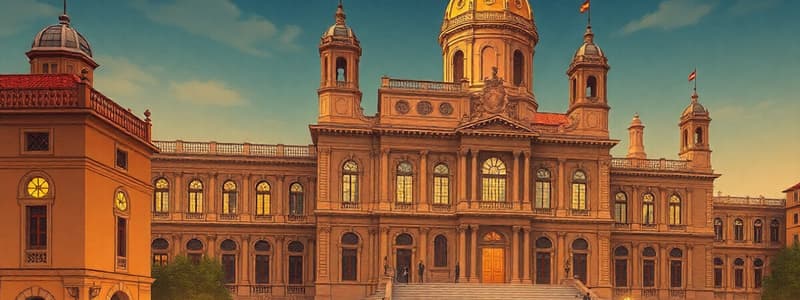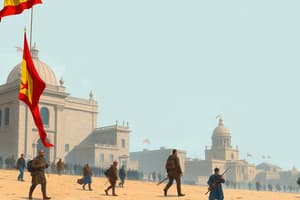Podcast
Questions and Answers
What significant reforms did Niceto Alcalá-Zamora implement during his presidency?
What significant reforms did Niceto Alcalá-Zamora implement during his presidency?
- Labor laws and tax reforms.
- Military reforms and constitutional amendments.
- Social welfare programs and education reforms.
- Electoral reforms and land reform initiatives. (correct)
Which external factors significantly influenced the leadership duration of presidents during the Second Spanish Republic?
Which external factors significantly influenced the leadership duration of presidents during the Second Spanish Republic?
- Cultural movements and artistic influences.
- International economic treaties and foreign pressure.
- Technological advancements and industry growth.
- Political crises, social upheaval, and civil war. (correct)
What characterized Manuel Azaña's presidency in 1936?
What characterized Manuel Azaña's presidency in 1936?
- Heightened political tensions leading to the Civil War. (correct)
- A period of economic prosperity and stability.
- A significant shift towards authoritarian practices.
- Establishment of a dictatorship and military rule.
In what way did regional tensions influence presidential leadership during the Second Spanish Republic?
In what way did regional tensions influence presidential leadership during the Second Spanish Republic?
What was a significant challenge faced by the presidents in the Second Spanish Republic with respect to their roles?
What was a significant challenge faced by the presidents in the Second Spanish Republic with respect to their roles?
How did the succession process among presidents contribute to the political stability of the Second Spanish Republic?
How did the succession process among presidents contribute to the political stability of the Second Spanish Republic?
Which factor most significantly curtailed the operations of the Second Spanish Republic by 1936?
Which factor most significantly curtailed the operations of the Second Spanish Republic by 1936?
What was one of the main political challenges during the Second Spanish Republic?
What was one of the main political challenges during the Second Spanish Republic?
Flashcards
Presidents of the Second Spanish Republic
Presidents of the Second Spanish Republic
The Second Spanish Republic (1931-1936) experienced several presidents due to political instability and rapid shifts in power.
Who was Niceto Alcalá-Zamora?
Who was Niceto Alcalá-Zamora?
Niceto Alcalá-Zamora served as president from 1931 to 1936, overseeing key legislative efforts like electoral reforms and land reform.
Who was Manuel Azaña?
Who was Manuel Azaña?
Manuel Azaña, a prominent Republican figure, became president in 1936, just before the start of the Spanish Civil War.
What influenced the length of presidential terms?
What influenced the length of presidential terms?
Signup and view all the flashcards
What were the political challenges faced by the Republic?
What were the political challenges faced by the Republic?
Signup and view all the flashcards
What was the impact of the Spanish Civil War?
What was the impact of the Spanish Civil War?
Signup and view all the flashcards
What influenced presidential transitions?
What influenced presidential transitions?
Signup and view all the flashcards
How did the political context influence the President's role?
How did the political context influence the President's role?
Signup and view all the flashcards
Study Notes
Presidents of the Second Spanish Republic
-
The Second Spanish Republic, established in 1931, experienced significant instability and political shifts. Rapid presidential succession reflected these internal pressures.
-
Niceto Alcalá-Zamora (1931-1936): Served as President during a pivotal period of the Republic, presiding over crucial legislative actions including electoral and land reforms.
-
Manuel Azaña (1936): Became President just before the Spanish Civil War. His leadership was hugely impacted by the escalating tensions and the war's outbreak.
-
The duration of these presidencies: Presidential terms varied greatly, influenced by political crises, social unrest, and ultimately, the Spanish Civil War.
-
Political context: The Republic faced numerous political challenges, including clashes between political factions. Growing anarchist and communist influence heightened these struggles. Regional tensions further destabilised national leadership efforts.
-
Impact of the Spanish Civil War: The 1936 Civil War had a devastating effect on the Republic's ability to function. This conflict directly disrupted operations and had far-reaching consequences.
-
Presidency transitions: Transitions were affected by the volatile political climate within Spain, actions of other political actors, and overall national instability.
-
Role of the President: The President's authority was shaped by the republican governmental structure and the shifting power dynamics amongst groups within Spanish society. Limitations on the President's mandate and powers frequently occurred.
-
Succession and continuity: The lack of a clear presidential succession process contributed substantially to the Republic's instability. Different political processes defined the transition of leadership.
-
Impact on the Republic: Frequent presidential changes severely hampered the Republic's capacity to effectively address critical national issues. Competing political views and varying interpretations of pertinent issues further complicated leadership.
-
Influence on the outcomes of the Republic The constant leadership transitions during this time significantly contributed to the republic's instability. These events impacted public perception of the government and the reactions of other political groups.
Studying That Suits You
Use AI to generate personalized quizzes and flashcards to suit your learning preferences.



